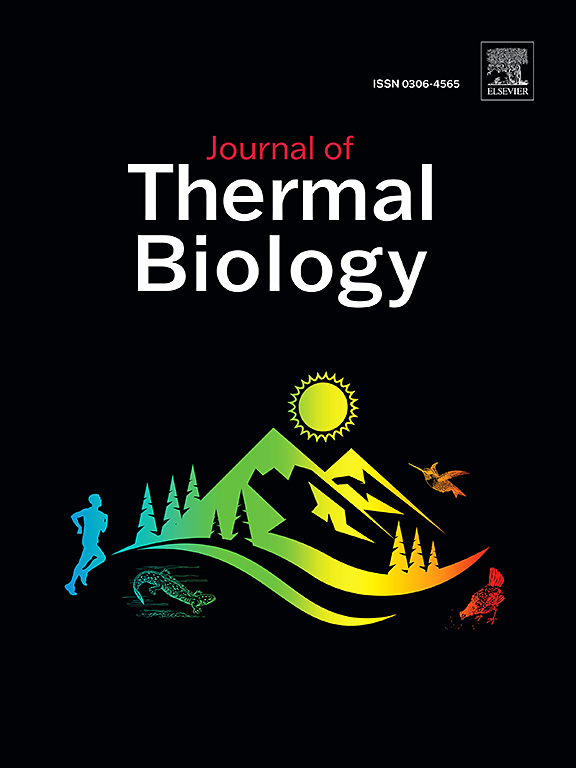Combining automated behaviour recognition and physiological data to characterize heat tolerance and animal welfare in growing pigs
IF 2.9
2区 生物学
Q2 BIOLOGY
引用次数: 0
Abstract
Estimating animal behaviour during heat stress (HS) is particularly insightful to monitor animal welfare but also to better understand how animals thermoregulate. The present study is a proof of concept combining computer vision to monitor animal behaviour, continuous monitoring of subcutaneous temperature and recording of ambient temperature, with the aim to study the link between behaviour and animal body temperature during HS. A total of 22 pigs were video-monitored from 8:00 to 18.00 under two contrasted conditions: HS corresponding to the tropical climate (between 20.3 °C and 27.9 °C) and Thermoneutral (TN) consisting of an indoor temperature-controlled room at 22 °C. Animal temperature (Tmuscle) and ambient temperature were monitored continuously using temperature loggers. Pig postures estimated by a neural network show that animal in HS spend more time lying laterally and less time lying sternally than in TN. Moreover, in HS, the length of the lateral sequences increased with the outdoor ambient temperature. The ability of an animal to dissipate heat while lying laterally was quantified through a Heat Dissipation Coefficient (HDC), combining Tmuscle and lateral lying sequence duration, and showed great individual variation. A Heat Discomfort Index (HDI) was also determined to quantify the difference in time spent lying laterally between HS and TN and could be useful as a proxy to quantify animal welfare reduction due to HS. This study demonstrates that combining image analysis to monitor animal behaviour and physiological data is an efficient tool to derive quantitative criterion to characterize animal welfare and traits related to heat tolerance.
结合自动行为识别和生理数据表征生长猪的耐热性和动物福利。
估计动物在热应激(HS)下的行为对监测动物福利特别有见地,也有助于更好地了解动物的体温调节方式。本研究是结合计算机视觉监测动物行为、连续监测皮下温度和记录环境温度的概念验证,旨在研究HS过程中动物行为与体温之间的联系。从8:00到18:00,对22头猪在两种对比条件下进行视频监控:HS对应于热带气候(20.3°C至27.9°C)和热中性(TN),包括室内温度控制在22°C的房间。使用温度记录仪连续监测动物体温(肌肉)和环境温度。通过神经网络对猪的体位进行估计,结果表明:猪的侧卧时间比正卧时间多,侧卧时间比正卧时间少,且侧卧序列的长度随室外环境温度的升高而增加。通过结合肌肉和侧卧序列时间的散热系数(HDC)来量化动物侧卧时的散热能力,并显示出较大的个体差异。还确定了热不适指数(HDI),以量化HS和TN之间横向躺卧时间的差异,并可作为量化HS导致的动物福利减少的代理。该研究表明,结合图像分析来监测动物行为和生理数据是一种有效的工具,可以得出定量标准来表征动物福利和与耐热性相关的性状。
本文章由计算机程序翻译,如有差异,请以英文原文为准。
求助全文
约1分钟内获得全文
求助全文
来源期刊

Journal of thermal biology
生物-动物学
CiteScore
5.30
自引率
7.40%
发文量
196
审稿时长
14.5 weeks
期刊介绍:
The Journal of Thermal Biology publishes articles that advance our knowledge on the ways and mechanisms through which temperature affects man and animals. This includes studies of their responses to these effects and on the ecological consequences. Directly relevant to this theme are:
• The mechanisms of thermal limitation, heat and cold injury, and the resistance of organisms to extremes of temperature
• The mechanisms involved in acclimation, acclimatization and evolutionary adaptation to temperature
• Mechanisms underlying the patterns of hibernation, torpor, dormancy, aestivation and diapause
• Effects of temperature on reproduction and development, growth, ageing and life-span
• Studies on modelling heat transfer between organisms and their environment
• The contributions of temperature to effects of climate change on animal species and man
• Studies of conservation biology and physiology related to temperature
• Behavioural and physiological regulation of body temperature including its pathophysiology and fever
• Medical applications of hypo- and hyperthermia
Article types:
• Original articles
• Review articles
 求助内容:
求助内容: 应助结果提醒方式:
应助结果提醒方式:


